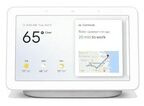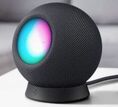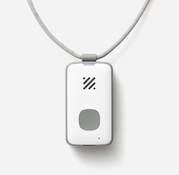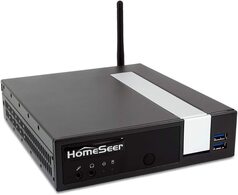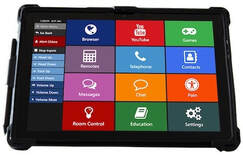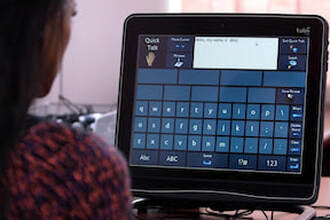|
Setting up a smart home can help you remain more independent and have greater control over your home environment. As ALS progresses, you may notice that it is becoming harder to do everyday things around the home, like turning on lights, adjusting the thermostat, and answering the door. Recent advances in smart home technology have made it possible to continue to do many of these things on your own, regardless of your physical limitations. |
What can smart home technology do for me?
Smart home technology can let you control electronic devices around your home by speaking, touching a screen, or using an alternative access method. With smart technology, you can:
It is also possible to program “if this, then that” (IFTTT) scenarios. For example, whenever you unlock the front door, the hall lights can be programmed to automatically turn on. |
|
Creating a Smart Home with Consumer Products
|
Smart home consumer products can be a great option for people living with ALS due to their affordability, flexibility, and ease of use. Today’s smart home devices operate through technology that many people already have: internet, Wi-Fi, and a smartphone or tablet.
Digital assistants like Amazon’s Alexa can be used with smart speakers, smart displays, phones, tablets, and computers. Once you set up your digital assistant and platform, you can choose from a wide variety of smart devices like bulbs, plugs, thermostats, and doorbells. These devices should be “plug and play,” meaning that if you are comfortable pairing devices with Bluetooth, you should be able to follow instructions and connect the devices yourself. |
|
|
If you can’t figure something out, you can try watching instructional videos online or ask a tech-savvy family member, friend, or neighbor to help you troubleshoot. You can also hire a smart home technician. Another benefit of going the consumer-products route is that you can start with just one or two devices and then add more as you feel more comfortable.
|
|
Choosing Your Digital Assistant Platform
You can control everything through a digital-assistant-powered platform that can be operated by voice and/or a customizable digital dashboard on your phone, tablet, computer, or smart display.
The most commonly used digital-assistant platforms are:
The most commonly used digital-assistant platforms are:
|
Google Assistant – This virtual assistant works through the Google Home app on devices like the Google Nest Hub smart display and Google Nest Mini smart speaker.
|
|
|
Apple’s Siri – The Apple HomeKit app comes preinstalled on iPhones and iPads and operates through the HomePod mini smart speaker.
|
|
The Amazon and Google platforms are compatible with thousands of third-party smart home products. Currently, Apple’s system is more closed and less compatible with third-party products. In general, compatibility between all smart home platforms and devices has improved and should continue to get better.
You can do online research, talk with smart home experts, and consult with your ALS occupational therapist, speech language pathologist, or assistive technology professional to determine which platform and smart speaker might be best for you. If you already have an Amazon, Google, or Apple device and feel comfortable with it, sticking with the platform you already know could make the most sense.
You can do online research, talk with smart home experts, and consult with your ALS occupational therapist, speech language pathologist, or assistive technology professional to determine which platform and smart speaker might be best for you. If you already have an Amazon, Google, or Apple device and feel comfortable with it, sticking with the platform you already know could make the most sense.
Safety Alert SystemsBecause not every digital assistant can call 911 directly, and because digital assistants rely on having power and Wi-Fi, your digital assistant should not be your primary emergency alert system. Learn about safety alert system options on our Home Safety page.
|
Choosing Your Smart Devices
Once you have chosen your Amazon, Google, or Apple platform, you can start researching and shopping for smart devices. Before purchasing a product, make sure that it is compatible with your platform. The packaging for each device will usually indicate which platforms are compatible. Many devices work across multiple platforms.
Here are some of the most common types of smart devices:
Here are some of the most common types of smart devices:
|
Smart bulbs are often the easiest entry point into smart home technology. You can buy a relatively inexpensive smart bulb, install it, download the app, and control your lighting—even without using a digital assistant and smart speaker. You can program your bulbs to turn on and off at certain times of the day, dim, etc.
|
|
|
Smart plugs are also simple and user-friendly. You can use them to turn devices on and off as long as the devices have mechanical switches and can be plugged into an outlet. You can use smart plugs for fans, electric blankets, suction machines, and other devices.
|
|
|
Smart video doorbells are popular for safety and convenience. If someone rings or knocks at your door, you can see who’s there and communicate with them over the intercom.
|
|
|
Smart locks are often used in conjunction with video doorbells. Once you see who is at the door, you can unlock the deadbolt. You can also assign virtual keys to specific people like family, friends, and caregivers so they can let themselves in.
|
|
|
Streaming media controllers can allow you to operate your television and switch between inputs like cable and streaming.
|
|
|
Smart video cameras can be used for both home security and personal safety. Should it be helpful, indoor cameras can allow caregivers to keep an eye on loved ones from another room or from outside the home.
|
|
|
There are many more types of smart devices. You can research and purchase them on sites like Amazon and Best Buy or visit stores like Best Buy, Target, or your local hardware store.
|
|
Are there other smart home setup options?
|
There are two other ways you could set up your smart home. Instead of purchasing consumer products and running them through a digital assistant like Alexa, you could either set up a hub or hire a company to install a custom system for your home.
|
|
|
Digital hubs centralize and coordinate all of your smart devices, whether they use Wi-Fi, Bluetooth, Z-Wave, or another wireless technology. This can be a good option if you are tech-savvy, motivated, and would like more sophisticated functionality than digital assistants like Alexa can provide. But setting up and using a hub can be a frustrating experience unless you have the technical expertise yourself or hire a smart home technician to help you with setup and troubleshooting.
|
|
The other option is hiring one company to come to your home to set up a closed custom system. Considered the gold standard, Environmental Control Units (ECUs) or Electronic Aids to Daily Living (EADLs) can provide the most sophisticated functionality, but they are also the most expensive option. The system itself is designed, engineered, manufactured, and installed by trained professionals. It is customizable and can control your entire home.
|
The company will provide technical support and keep up with changes in technology. However, because it is a closed system, outside technicians may not be able to help you troubleshoot, and your system may not integrate with popular consumer-grade smart devices.
How much will everything cost?
Home automation costs are not covered by Medicare, Medicaid, or private insurance. However, if you are a military veteran with service-connected benefits, the VA will likely cover all of your home automation costs—even the more expensive custom systems.
With differing individual needs and many different companies and devices, it is hard to estimate what a smart home setup will cost. Generally speaking—when factoring in devices, install, and support—custom systems will cost the most, hubs less, and consumer products the least.
Depending on the size of your home and the number of devices you want, purchasing consumer products for the most essential functions for part of your home could cost around $1,000. For more devices covering a larger area, it could be closer to $2,000.
If cost is a concern, you can ask your local ALS organization or ALS clinic if they have a smart home program, devices in their equipment loan closet, or suggestions for financial support. Another option is asking your state’s Assistive Technology Program if you can try out short-term loaner devices and/or get technical support.
With differing individual needs and many different companies and devices, it is hard to estimate what a smart home setup will cost. Generally speaking—when factoring in devices, install, and support—custom systems will cost the most, hubs less, and consumer products the least.
Depending on the size of your home and the number of devices you want, purchasing consumer products for the most essential functions for part of your home could cost around $1,000. For more devices covering a larger area, it could be closer to $2,000.
If cost is a concern, you can ask your local ALS organization or ALS clinic if they have a smart home program, devices in their equipment loan closet, or suggestions for financial support. Another option is asking your state’s Assistive Technology Program if you can try out short-term loaner devices and/or get technical support.
Selecting Your Best Access Method
|
No matter which system or digital assistant you have, you should be able to access your platform. The occupational therapist, speech language pathologist, or assistive technology professional from your ALS clinic or medical team should be able to help you determine which access method is best for you.
If you can still use the touchscreen on your phone or tablet, you can access the app directly. This is often referred to as the “direct select” method. If you can speak but are unable to use a touchscreen, you can give voice commands directly to your digital assistant. Keep in mind that digital assistants may struggle to understand impaired speech. |
If you are unable to use your hands or voice, alternative access methods include using a head mouse, wheelchair head array, or switches that can be operated by different parts of the body. If you are in a power wheelchair, you can use the joystick to operate the app on your phone or tablet.
If you have a speech-generating device (SGD), you can use eye-tracking technology to speak your commands out loud to your voice-activated assistant and smart speaker. Ask your speech-language pathologist or SGD representative to help set up your digital assistant app and pre-program common commands.
You can also pre-program common commands into your phone or tablet so they can be spoken aloud to activate a virtual assistant like Alexa.
If you have a speech-generating device (SGD), you can use eye-tracking technology to speak your commands out loud to your voice-activated assistant and smart speaker. Ask your speech-language pathologist or SGD representative to help set up your digital assistant app and pre-program common commands.
You can also pre-program common commands into your phone or tablet so they can be spoken aloud to activate a virtual assistant like Alexa.
Getting Started
It is never too late to set up, learn to use, and benefit from smart home devices. The following Smart Home Quick Reference Guide and Planner can help you get started.
Smart Home Quick Reference Guide
Setting up a smart home with consumer products can help you continue to do things like turn your lights on and off and adjust the thermostat. Smart home technology can be empowering, but it can also be frustrating when things aren’t working right.
If you don’t feel confident setting up smart home devices, you can either try watching online instructional videos or ask a tech-savvy family member, friend, or neighbor for assistance. Your ALS occupational therapist, speech language pathologist, or assistive technology professional may also be able to help.
For setup and troubleshooting, you can always hire a smart home technician. Device manufacturers may also be able to provide tech support. Keep in mind that software updates may change the appearance of your apps. Try to keep serial numbers, support phone numbers, and passwords for every device in one place.
Start with reliable internet and Wi-Fi. Consumer-grade smart home devices run through your internet and Wi-Fi. This means you will need a modem for your internet and a router to emit the wireless signal. You may need to reset your router from time to time. If you do not have internet or Wi-Fi, you may want to look into a hub system that uses other wireless technology like Z-Wave that can still activate devices without Wi-Fi.
Choose your digital assistant platform. The main three choices are Amazon’s Alexa, Google Assistant with Google Home, and Apple’s Siri with HomeKit. Alexa may be the most powerful and user-friendly option. Apple supports fewer third-party devices.
Choose your smart speaker(s) or display(s). Each company has its own line of evolving smart speakers and speakers with smart displays. Though you can operate any voice assistant with just your phone or tablet, you will get more functionality when you have one or more smart speakers or displays.
Customize your dashboard and sync your contacts. Download the app for your digital assistant platform onto your phone, tablet, computer, or smart display and become familiar with the interface. Customize as desired and sync your contact list.
Choose your smart devices. After deciding what you want to automate, research and purchase the devices that will best meet your needs. Make sure that each device is compatible with your Amazon, Google, or Apple platform.
Connect and label your smart devices. Each device should be “plug and play,” meaning that you should be able to follow instructions and pair it with your phone, tablet, computer, or smart display. Be sure to label your devices both digitally and physically in a clear way that you will remember, such as “Living Room Lamp.”
If you don’t feel confident setting up smart home devices, you can either try watching online instructional videos or ask a tech-savvy family member, friend, or neighbor for assistance. Your ALS occupational therapist, speech language pathologist, or assistive technology professional may also be able to help.
For setup and troubleshooting, you can always hire a smart home technician. Device manufacturers may also be able to provide tech support. Keep in mind that software updates may change the appearance of your apps. Try to keep serial numbers, support phone numbers, and passwords for every device in one place.
Start with reliable internet and Wi-Fi. Consumer-grade smart home devices run through your internet and Wi-Fi. This means you will need a modem for your internet and a router to emit the wireless signal. You may need to reset your router from time to time. If you do not have internet or Wi-Fi, you may want to look into a hub system that uses other wireless technology like Z-Wave that can still activate devices without Wi-Fi.
Choose your digital assistant platform. The main three choices are Amazon’s Alexa, Google Assistant with Google Home, and Apple’s Siri with HomeKit. Alexa may be the most powerful and user-friendly option. Apple supports fewer third-party devices.
Choose your smart speaker(s) or display(s). Each company has its own line of evolving smart speakers and speakers with smart displays. Though you can operate any voice assistant with just your phone or tablet, you will get more functionality when you have one or more smart speakers or displays.
Customize your dashboard and sync your contacts. Download the app for your digital assistant platform onto your phone, tablet, computer, or smart display and become familiar with the interface. Customize as desired and sync your contact list.
Choose your smart devices. After deciding what you want to automate, research and purchase the devices that will best meet your needs. Make sure that each device is compatible with your Amazon, Google, or Apple platform.
Connect and label your smart devices. Each device should be “plug and play,” meaning that you should be able to follow instructions and pair it with your phone, tablet, computer, or smart display. Be sure to label your devices both digitally and physically in a clear way that you will remember, such as “Living Room Lamp.”
Smart Home Planner
Before choosing your smart home platform and devices, it can be helpful to reflect on how your smart home could be most helpful for you. Answering the following questions can help you prioritize and determine which options will be best.
Which of the following smart home features would be most helpful?
Which rooms in your home would you like to automate?
How basic or sophisticated would you like your home automation to be?
Basic /Intermediate / Sophisticated
How tech-savvy do you consider yourself when it comes to smart devices?
Beginner / Intermediate / Expert
Do you have tech-savvy family or friends who could help? If so, who?
What will be your best access method?
Notes:
Which of the following smart home features would be most helpful?
- Turning lights on and off
- Adjusting the thermostat
- Controlling your TV and other entertainment devices
- Making phone calls and sending text messages
- Answering and unlocking your door
- Turning small appliances on and off
- Controlling specific outlets
- Operating your home security system
- Communicating between rooms via intercom
- Other:
Which rooms in your home would you like to automate?
How basic or sophisticated would you like your home automation to be?
Basic /Intermediate / Sophisticated
How tech-savvy do you consider yourself when it comes to smart devices?
Beginner / Intermediate / Expert
Do you have tech-savvy family or friends who could help? If so, who?
What will be your best access method?
- Touching my phone or tablet (direct select)
- Speaking voice commands
- Using eye-tracking technology
- Another access method:
Notes:




